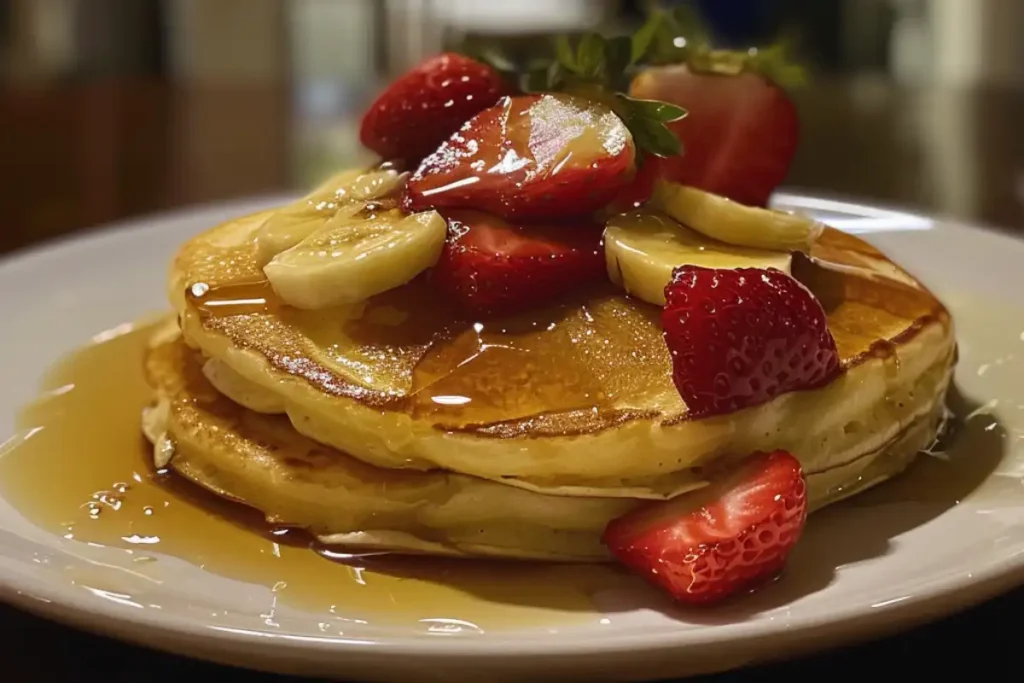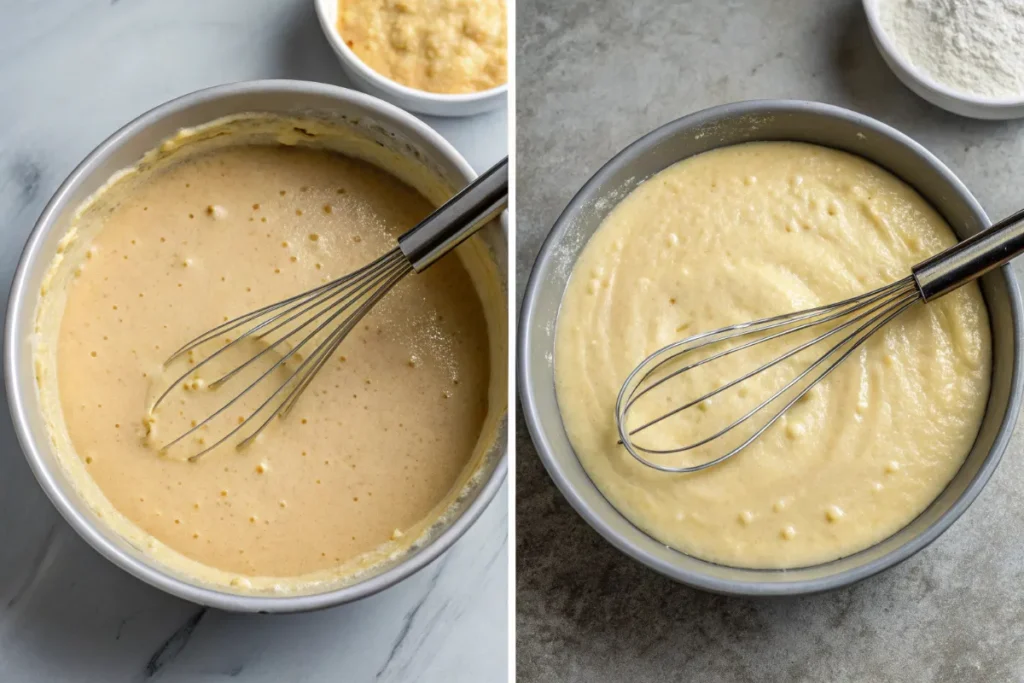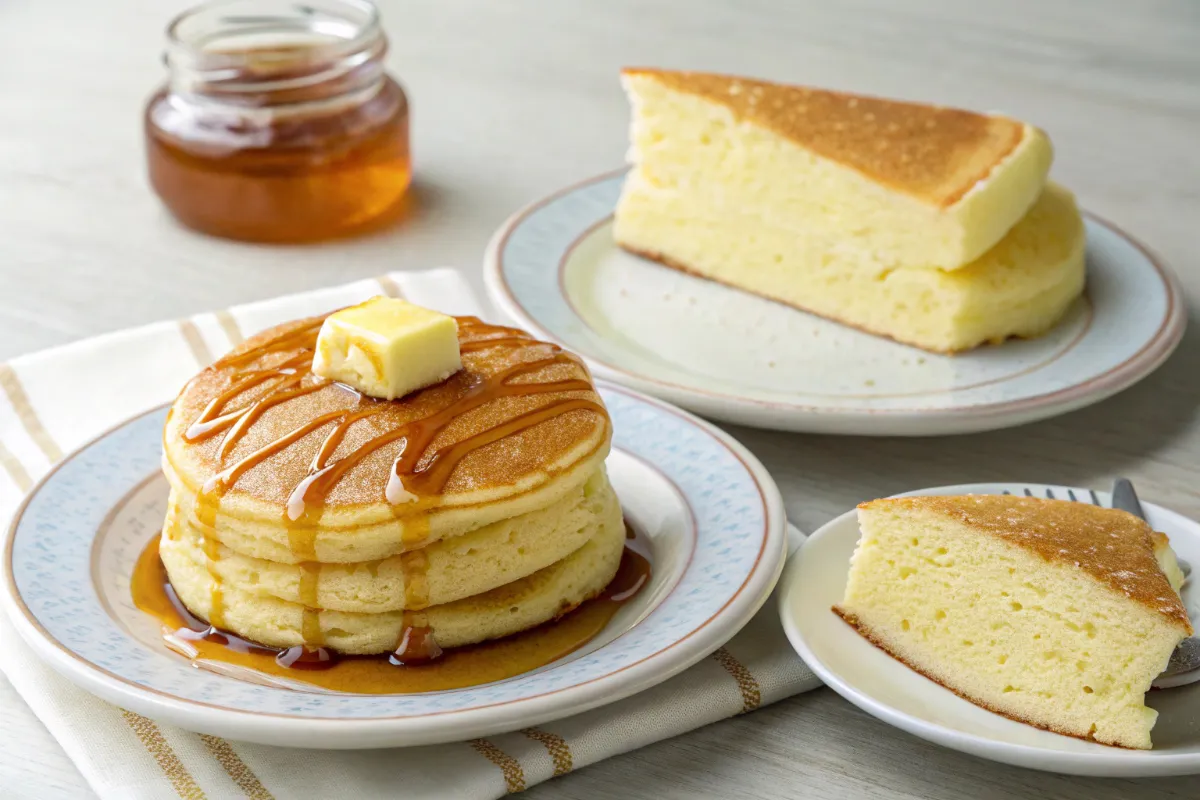When you think of pancake batter and cake batter, they might seem interchangeable at first glance. Is pancake and cake batter the same? Not quite. While both share common ingredients like flour, eggs, milk, and leavening agents such as baking powder, they differ significantly in composition, texture, and final culinary uses. Pancakes are light, airy, and quick to cook, while cakes are rich, dense, and baked to perfection
Table of Contents
Is pancake and cake batter the same : Key Differences
What is Pancake Batter?

Pancake batter is a simple mixture used to make breakfast pancakes. The goal is to create light, fluffy, and slightly chewy pancakes with a golden-brown exterior. The batter consists of basic ingredients such as flour, eggs, milk, and a leavening agent like baking powder or baking soda. Pancake batter is typically thin enough to spread easily on a hot griddle or pan but thick enough to create small bubbles as it cooks.
Pancakes are quick to prepare, making them a breakfast favorite around the world. They are usually topped with butter, syrup, whipped cream, or fruits, depending on individual preferences.
Basic Ingredients for Pancake Batter:
- 1 cup all-purpose flour
- 1 tablespoon sugar
- 2 teaspoons baking powder
- 1/2 teaspoon salt
- 1 cup milk or buttermilk
- 1 large egg
- 2 tablespoons melted butter or vegetable oil
The key to achieving perfect pancake batter lies in the ratio of wet to dry ingredients. The batter should be smooth and thin enough to pour but not runny. The leavening agents in the batter—baking powder or baking soda—help create bubbles that cause the pancake to rise and become light and fluffy as it cooks on the griddle.
If you're curious about what makes pancakes so light and airy, check out Why Are Restaurant Pancakes So Fluffy? for a deeper dive into the secrets behind their perfect texture!
What is Cake Batter?
Cake batter, in contrast, is richer and designed for baking, resulting in a moist, spongy cake. Cake batter includes more fat and sugar than pancake batter, which gives the cake a tender crumb and a structure that can hold heavier toppings like frosting, glaze, or fruit. The batter is much thicker than pancake batter and takes longer to cook in an oven, where the heat slowly causes the batter to rise and set into a stable cake form.
Cakes are often sweet and rich in flavor, and they can come in various forms, from light sponges to dense pound cakes.
Basic Ingredients for Cake Batter:
- 2 cups all-purpose flour
- 1 cup sugar
- 1/2 cup butter (or oil)
- 3 large eggs
- 1 teaspoon vanilla extract
- 1 1/2 teaspoons baking powder
- 1/2 teaspoon salt
- 1 cup milk
Cake batter is designed to rise evenly in the oven, creating a stable, fluffy cake. The higher fat content helps trap air within the batter, giving cakes their signature rise. The sugar and butter in the batter also contribute to the moistness and tender crumb of the finished cake.
For more cake recipes that make use of perfect batter techniques, explore Red Velvet Bundt Cake for a rich and indulgent dessert option.
Is pancake and cake batter the same : Texture and Cooking Methods

Pancakes
- Pancakes are cooked on a hot griddle or pan, where the batter spreads and begins to puff up almost immediately. The leavening agents in the batter cause bubbles to form, creating a light and fluffy texture. This quick cooking process highlights the difference between the two—is pancake and cake batter the same? Not quite. While pancakes are ready to eat within minutes once golden brown, cake batter requires a longer baking time to develop its rich, spongy structure
If you’re feeling adventurous, you can even turn your pancakes into a cake-like dessert by layering them with frosting or whipped cream, check out Pancake Cake.
Cakes
- Cakes, on the other hand, are baked in the oven at a lower temperature for a longer period of time. The heat causes the batter to rise slowly, allowing the leavening agents to create a spongy texture. This contrast raises the question—is pancake and cake batter the same? Not quite. Cake batter is thicker than pancake batter, allowing it to hold its shape in the pan as it rises. The longer baking time also ensures that the cake is cooked evenly all the way through. Cakes can take anywhere from 20 to 45 minutes to bake, depending on the recipe
For more creative ways to use batter, visit How to Make Cinnamon Roll Pancakes for a delicious twist on classic pancakes.
Can You Substitute Pancake Batter for Cake Batter?
You can technically substitute pancake batter for cake batter, but is pancake and cake batter the same? Not exactly. Because pancake batter contains less fat and sugar, the resulting cake will be denser and less sweet. The batter also lacks the structure needed to support a cake’s rise, so the cake may not rise as much or hold its shape as well as a traditional cake.
To make pancake batter more suitable for baking, you can add extra fat and sugar to the recipe. You may also need to increase the amount of baking powder to help the cake rise in the oven. However, even with these adjustments, the cake will be denser and less fluffy than a typical cake
For tips on how to adapt pancake batter for baking, check out Can You Bake Pancake Batter? for a detailed guide.
Is pancake and cake batter the same : Nutritional Comparison
Is pancake and cake batter the same when it comes to nutrition? Not quite. Here’s a quick breakdown of the nutritional differences between pancake batter and cake batter. As you might expect, cake batter tends to be higher in calories, fat, and sugar due to the added butter and sugar
Pancake Batter (per 100g):
- Calories: ~200
- Fat: 5g
- Sugar: 3g
- Carbohydrates: 35g
Cake Batter (per 100g):
- Calories: ~350
- Fat: 15g
- Sugar: 25g
- Carbohydrates: 50g
Cakes are higher in calories and sugar, making them a more indulgent option compared to pancakes. This difference highlights the question—is pancake and cake batter the same? Not quite. If you’re looking to lighten up your recipe, you can substitute whole wheat flour or reduce the sugar content in both batters.
Common Mistakes When Using Pancake and Cake Batter
1. Overmixing the Batter
- Overmixing is one of the most common mistakes when working with both pancake and cake batter. Overmixing causes the gluten in the flour to overdevelop, resulting in a tough, dense texture. To avoid this, mix the batter just until the ingredients are combined. Small lumps are okay—they’ll smooth out during cooking or baking.
2. Using the Wrong Ratios
- Using the correct ratios of wet and dry ingredients is key to getting the right texture for both pancakes and cakes. Too much flour or too little milk can result in a thick, heavy pancake, while too much liquid can make the batter too runny. Similarly, cakes require the right balance of butter, sugar, and leavening agents to rise properly and maintain a light texture.
Is pancake and cake batter the same? While they may seem similar at first glance, they serve very different purposes in the kitchen. Pancake batter is designed for quick, light, and fluffy pancakes, while cake batter is richer and thicker, meant to create a moist, spongy cake. Understanding these differences can help you achieve the perfect texture and flavor for whatever dish you’re making
FAQs About Is pancake and cake batter the same
1. Can You Make Pancakes from Cake Batter?
- Yes, you can make pancakes from cake batter, but they will be sweeter and denser than traditional pancakes. You may need to thin the batter with additional milk or water to achieve the right consistency for pancakes.
2. Why is Cake Batter Fluffier than Pancake Batter?
- Cake batter is fluffier because it contains more fat and sugar, which help trap air and create a spongy texture during baking.
3. How Can You Make Pancake Batter More Like Cake Batter?
- To make pancake batter more like cake batter, add extra butter and sugar to the recipe, and increase the amount of baking powder to help the batter rise.
4. Why is Pancake Batter Runny Compared to Cake Batter?
- Pancake batter is runny because it needs to spread out on a griddle and cook quickly. Cake batter, on the other hand, is thicker to hold its shape in a cake pan and rise slowly in the oven.

